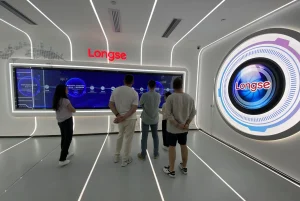Navigating Telecom Market 2024-2025: Insights and Aipix’s Vision
The telecom industry is leading the charge in innovation. Fueled by breakthroughs in generative AI, the expansion of 5G and growing customer demand for personalized seamless services. Aipix has evolved in tandem with the telecom sector, contributing to projects that not only drive our growth but also empower telecom providers and ISPs to advance, making the world smarter and safer. In this article, we delve into an exclusive conversation with Alexander Baiko. Our solution architect uncovers key insights, industry trends, and how Aipix is adapting to them and shaping its vision for the future of telecom.
Telecom Market Insights and Trends
Q: What are the key changes you have noticed in the telecom market trends?
Alex: First and foremost is the adoption of generative artificial intelligence in marketing, data analytics, and network management. For example, AI helps operators predict network problems and minimize customer churn through personalized offers. The development of 5G networks in turn opens up new opportunities to expand the use of IoT and technologies such as FWA, stimulating the development of operator infrastructure. One of the important changes is a different perspective on replacing traditional services with operator solutions. This fully applies to video surveillance services, access control services and security services in general.
Q: What challenges have become the most significant for Aipix customers – telecom operators and ISPs – in 2024?
Alex: Operators have almost completed or are in the final stages of building traditional fiber-optic infrastructure in the places where they operate. The usual operator services, such as Internet and TV, they are no longer generating enough revenue. In order to increase ARPU, operators are forced to look for new services for development, which were previously considered traditional.
Q: What are the main requests from private, corporate and public clients of your customers?
Alex: The main market demands dictate the need to develop security services. They are PSIM, cloud video surveillance, video analytics, smart intercom, and additional protection of network traffic from threats. Users often turn to a telecom operator for these services due to the operator’s proximity and convenience of receiving, paying and servicing. Businesses have a need to focus on the core value of their operations and put the service functions in the hands of professionals. In a highly competitive environment, the struggle for efficiency prevents spending a lot of resources on non-core types of services that are necessary to support the business but do not directly create value.
Q: How has the demand for video surveillance, video analytics and intercom services changed in different regions?
Alex: Demand is certainly growing. But how is this demand being met? Here is the main pain point for the user. He’s not have to understand the technical details of architectures or do everything with his own hands. This is taken advantage by small companies. That provide users with solutions that, after installation, remain unattended and force them to spend time on maintenance and repair. I see a trend towards the emergence of telecom operators in this market who can provide unified solutions to their users and offer additional service, freeing up the user’s time. The world is moving towards simplification. Service can be as complex as you want it to be, but it should be easy to use. As a consumer, I’m willing to pay monthly for a service, but to be a user of it, not to understand the technical intricacies. There is great potential for growth.
Platform advances and Technological Adaptations
Q: How has Aipix adapted platform to market changes?
Alex: Our platform provides a single management interface for value-added services (VAS) and is designed specifically for telecom operators to meet their needs. The basis of service provision by the operator from a single platform is multitenancy. That means sharing a common platform for all users, and from the user’s point of view he has his own personal service. For example, video surveillance system, as if it were at home. In this way the operator serves hundreds of thousands of platform users with the help of one or two administrators. This is a key difference compared to traditional systems. The challenge for us was to provide true isolation of the user’s services from other users.
Over the course of this year, we have expanded the number of services that an operator can provide to its users through our platform. These are new services such as firewall as a service and wireless access as a service. It is also a significant expansion of support for third-party cameras, intercom panels, adding new scenarios for the use of video analytics. We have released new software for installation on cameras and local devices connecting cameras within a local network (bridge). All of this allows telecom operators to not only increase the range of services, but also expand their presence on various geographic market, add new users to their subscriber base, and grow faster than the competitors.
Q: What projects have become landmark and new among basic requests from clients?
Alex: Our platform was originally designed for the rapid launch of mass services. The main typical request, as well as the main problem in using traditional software, is how to make the service work for hundreds of thousands of users at once. This is unattainable with traditional software that the customer installs. Even if the service is successful. If the operator can’t scale it to meet demand in a matter of weeks, the service will suffer an unenviable fate. The investment in launching the service and marketing will never pay off.
I also regularly receive requests for consolidation of additional services under management from a single application. It is convenient for users to use one application for video surveillance, intercom, and analytics instead of several. The main request is for simplicity and convenience for subscribers.
Q: What innovations and telecom trends have you implemented in the Aipix platform to accelerate service deployment by your customers?
Alex: A year ago we switched to installing our platform in the Kubernetes environment. That allowed our customers to receive updates without service interruption for subscribers, and manage the economy of resources used. We also developed a unified storage of logs from all services of the platform and comprehensive monitoring of its operation parameters.
Another of our tasks was to attract users for the telecom operator by expanding market segments. With the help of Bridge and Camera Agent operators were able to connect users in places where there is no operator’s infrastructure, and the availability of applications for all known platforms, including an application for Windows allowed to attract those users who need a stationary place for video surveillance with the possibility of using video cubes and multi-monitor configurations. Our client allows up to 250 cameras to be displayed on up to 5 screens simultaneously using a typical desktop computer.
These innovations have allowed us to create an ecosystem of value-added services that significantly expands the scalability of the platform itself, as well as coverage of new market segments.
Telecom Trends: Target Markets and Geography
Q: What are the unique challenges in Latin America and Asia, and how is Aipix responding to them?
Alex: Different markets require a customized strategy to successfully launch services based on our platform. Central Asian markets are in a phase of rapid growth. To ensure competence in these markets, we are actively helping telecom operators at all stages of service launch, from marketing materials to subscriber service scenarios. The transition from traditional methods of selling cameras, intercoms, and access devices to selling as an operator service requires a great deal of attention in markets where explosive growth is occurring. With the evolutionary process of adopting innovation sometimes failing to keep pace with technology.
Customers in Latin America expect high reliability of video surveillance-based systems, especially in high-crime environments, and have increased demands for platform flexibility and customization to meet local legislative requirements. Our modular fault-tolerant platform organically fits into these requirements, the architecture is initially focused on telecom operators and comprehensive integration with operator systems – network, subscriber and service accounting systems, inventory and engineering systems. Suffice it to say that the level of automation of our platform allows us to connect and configure equipment without human intervention, controlling the entire process from the arrival of equipment in the warehouse to its write-off.
Q: Are you planning to expand your presence in markets other than the regions you already cover?
Alex: There is no doubt that we are aiming for a global presence and are ready to partner in those regions that were not mentioned above. At the same time, we are very careful about the quality of our services and operator support at all stages of launch and operation of our platform. Growth for growth’s sake is not our way. We carefully plan our development strategy, invest resources in preparing training programs for our partners and developing our partner network. We need to be as close to our customer as possible and be confident in our partners.
Technology trends in future
Q: What technologies do you see as the most promising for telecom operators in the next 3-5 years?
Alex: Among all the trends, I would like to point out the two that are most relevant to our strategy.
This is Edge computing, which together with cloud services will allow operators to offer flexible and scalable services, provide users with low latency and high reliability for applications that require real-time data processing, which undoubtedly include video surveillance-based services. Moving some of the computation to endpoints also frees up resources for the operator, who can in turn enrich the computation data with more powerful algorithms that run on the operator’s premises.
The second trend is undoubtedly the inclusion of AI in our platform. The main task of video surveillance-based services for the user is to correctly interpret the events taking place with minimal time spent. AI will both systematize and aggregate events from multiple devices and track anomalies from day to day, highlighting those events that are out of the norm. Systems that don’t provide truthfulness or are overwhelmed by the sheer number of events will quickly cease to be trusted or pay attention to those events. In this case, AI fits very well into our platform, allowing us to filter and predict those events that are important to us.
Year-End Results and Aipix’s Strategic Vision
Q: How do you see the future of the Aipix platform and its role in transforming the telecom industry?
Alex: In some ways, our platform is ahead of its time. People are familiar with the traditional methods of selling video surveillance equipment and systems, intercoms, video analytics, etc. When I want to install video surveillance for my home, I turn to a company that does just that. I just don’t know that buying turnkey video surveillance as a service is possible. We are not primarily transforming the telecom industry, we are anticipating people’s needs for fast and convenient security services and meeting them together with telecom operators. We want people to spend the time saved on immersing themselves in technology on themselves and their environment. Together with telecom operators, we can achieve this by making people’s lives easier.
Unlock the power of cloud video surveillance with Aipix — our experts are ready to help you get started.
Or leave request for free consultation:





